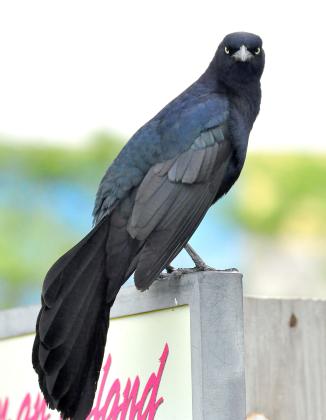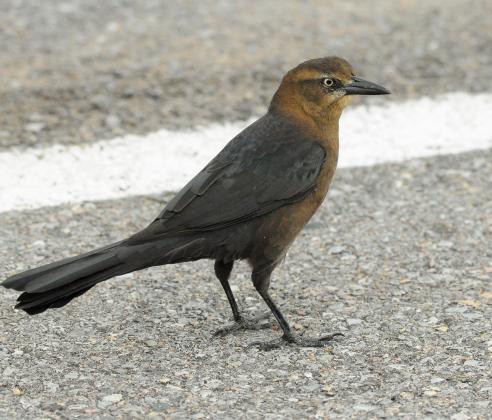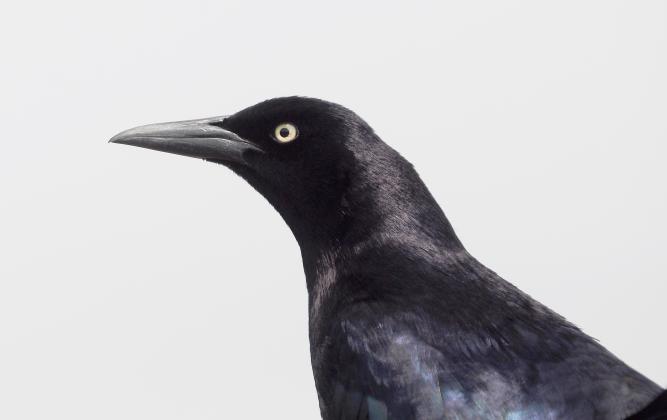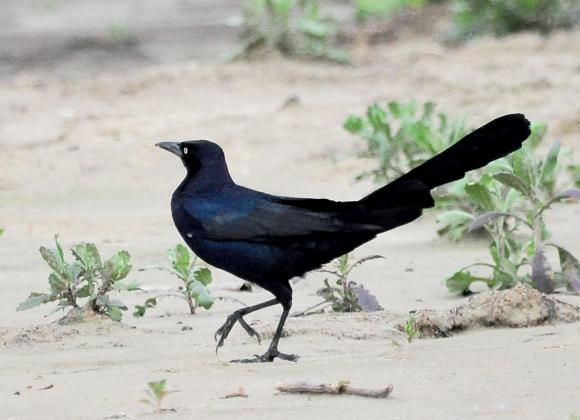This week’s featured creature is a most peculiar bird.
It is abundant, and you’ve almost certainly seen it at busy department store parking lots. In fact, where people go, so goes the great-tailed grackle.
I’m featuring this bird now as I will soon feature a close relative of the great-tailed grackle that is more rural, but people often confuse the two species.
In 1900, the very northern edge of the great-tailed grackle’s range barely reached southern Texas, according to the Cornell Lab of Ornithology. But great-tailed grackles have followed the spread of irrigated agriculture and urban development into the Great Plains and the American West.
And maybe you’ve heard them. They make sounds straight out of a science fiction movie. If you ever just stop and watch one, you’ll be amazed by the call notes they make — lots of clicks and clacks and other weird sounds. And then there is one combination where they puff up and sound off with a stream of odd noises that remind one of the “Star Wars” movies. It’s very loud as well.
I’m not a huge fan of these birds, mostly because they can bully other birds, but that happens a lot in nature. Much like starlings, house sparrows, cowbirds, etc., they are also considered a nuisance. But I do respect their intelligence.
I recall one time when I was in a parking lot waiting for someone. I noticed a great-tailed grackle walk up with a mission in mind. He jumped up on the grille of the vehicle in front of me and proceeded to pick out all the freshly killed insects (grasshoppers, butterflies, etc.) on the front of that car.
“How smart is that?” I thought to myself. “Instead of working hard to collect food, if you hang out in a busy parking lot, the food comes to you.”
I also witnessed that behavior this past summer, also in a parking lot. I had just driven through an area which seemed to have swarms of grasshoppers. After traveling through the area, the front of my vehicle was covered with dead grasshoppers. As soon as I stopped in a parking lot, my vehicle was besieged by grackles, which took advantage of the fresh food supply.
But as I said before, they can be a nuisance.
In a 2013 article in USA Today titled, “Troublesome great-tailed grackle spreads north, west,” it was reported that the birds can damage citrus crops (probably not a big problem around here) and that their droppings can spread disease. However, the article did not specify any diseases.
One of the biggest problems with these birds in cities is the number of droppings they leave behind, especially when roosting.
Great-tailed grackles tend to form roosting congregations in trees near or in parking lots and in parks and make quite a racket in the process. If you’ve ever visited a store or restaurant at night and heard unlimited robot speak coming from the trees, there is a good chance it was grackles.
The USA Today article stated that some businesses and municipalities have tried loud cannon fire to scare the birds away, to no avail. It seems the elaborate use of firecrackers has worked in some places, though.
And we certainly have them at parking lots here in Ada, but great-tailed grackles are not nearly as abundant as they are in Texas.
Appearance
The male great-tailed grackle is iridescent black and purple in color. At 15 to 18 inches, the male is about the same the same length as a crow, but its body is quite a bit smaller. It has an exceptionally long tail, and fairly long legs.
The female is a bit smaller than the male, and so is her tail. She is a golden-brown color around the head, breast, and belly, but her wings and tail are more bronze to black in color.
Diet
Everything.
That’s not exactly true, but sadly, it’s not far off. Grackles forage on the ground and in low brush. They are omnivorous and will eat grains, seeds and fruit year-round. During warmer months, they also eat insects, spiders, small snakes, lizards, fish, mice, and even the eggs and nestlings of other birds.
I’ve also seen them eat bread, french fries, etc., while roaming in parking lots.
Habitat
Parking lots.
Actually, great-tailed grackles prefer habitats with a place in which to forage and access to water. This includes urban, suburban, and rural areas. They frequent parks, neighborhoods, parking lots, farmland, hedgerows, thickets, irrigated fields, and marshes.
Nesting
Great-tailed grackles are polygamous and nest in colonies. According to the National Audubon Society, while in courtship and territorial display, the male perches in the open, fluffs out his feathers, partly spreads his wings and tail, and rapidly flutters his wings while making harsh calls. He will also posture with his bill pointed straight up, mainly as a threat display to other birds.
If you’ve been around these birds for any amount of time, you’ve probably seen them do just that.
According to the Cornell Lab of Ornithology, the female will lay one to five eggs. Incubation takes two weeks, while young are ready to leave the nest after about three weeks.
Range
The great-tailed grackle continues to spread north and west. It can be found all over Oklahoma, Texas, Kansas, and west to California.
Odds & Ends
• Please remember to check out my Randy’s Natural World on YouTube -- www.youtube.com/user/randyadventure.
Editor’s Note: Randy Mitchell is a freelance writer and photographer. He has been an avid birdwatcher, nature enthusiast and photographer for more than 40 years. Reach him at rnw@usa.com.





